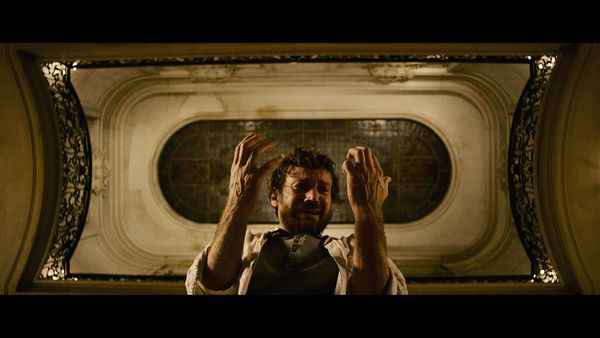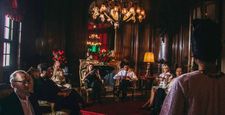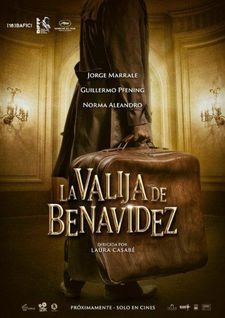 |
| Benavidez faces up to what's in the case |
One of the more unusual offerings at this year's Horror Channel Frightfest, Argentinean mystery Benavidez's Case tells the story of a troubled artist seeking help from a psychiatrist who makes a living selling his patients' art - a psychiatrist who has very little time for him until he sees what's in his suitcase. A tale of labyrinths both physical and psychological, full of satirical comment about both the art world and our treatment of the mentally ill, it's the second feature by director Laura Casabé. Part of a new wave of filmmakers pushing the boundaries of Argentinean cinema, she was happy to talk about her work, and though shy about the quality of her English, she wasn't slow to express her feelings about her film being selected for the celebrated horror festival.
"I’m really excited," she says. "I met Alan – you know the film was part of this thing in Cannes and I met Alan Jones there, the director of the festival, and he had already seen my movie and we talked and I love him. I think he’s great. And I’m so excited. And I’m going to be there for the whole festival so I’m going to watch a lot of movies."
Does she think of Benavidez's Case as horror?
"I think it’s mixed genre. I didn’t want to put the movie in a particular genre. Obviously I love horror and I love science fiction, and genre movies, they’re my favourites, but actually the movie is based on a short story of an Argentinean writer [Samanta Schweblin] and I am a big fan of her, I think she’s great. So I just read this tale and I wanted to do a movie, and then it turned out to be a mix of genres."
So what drew her to it?
 |
| Inside the residence, where psychiatry meets art |
"I actually do love the universe of this kind of psychotic madhouse and the universe inside the house of the curator, all the hypocrites and snobby people, and the end of the story. Actually the movie and the short story are not very similar, but the ending... the story has maybe ten pages, it’s very short – but I remember when I read it when I was young I was really impressed about the ending. .. I thought that it was really shocking and I wanted to shoot that scene."
She also had some familiarity with the art world at the outset.
"I made a lot of research and I have a lot of friends that are actually painters ad young artists so it was kind of close to me and I think maybe that was why I found it appealing. I have a lot of young friends that are trying to get a breakthrough, going to all these parties, and they are trying to put their works in several galleries or trying to meet the right person, you know? I talked a lot with a famous curator here in Argentina and my friends who are painters and sculptors so they could tell me their experience."
I mention a film which I saw at this year's Glasgow Film Festival, a true story that touches on similar issues. Nise – The Heart Of Madness recounts one woman's quest to bring art into the lives of psychiatric patients in Brazil. It's clear that this can be very therapeutic, but isn't there also a danger that it can be exploited, with some institutions making a tidy profit from their patients' work?
"Absolutely. That was exactly the thing, and thank you so much for saying so, so clearly!" she says. "When I was young I worked in a psychiatric unit here as a volunteer with several patients. They have this art workshop and actually made them very good. So I have that experience of the relationship between art and madness and how they can be curated, but the point here with this psychiatrist is he’s kind of the villain. He knows all that and he uses that to manipulate this character and to use him for his own profit. So that was kind of the thing – the way that some people use that kind of energy of the artist and promise them success and all that, and they actually exploit them and take advantage."
Another thing I was left wondering about after watching the film was who the therapy featured in it was for. Was it really intended to cure Benavidez, or to turn him into the type of artist who could make his supposed benefactors more money?
 |
| "Eccentric, but not too eccentric" art scene attendees |
"Both things," she says firmly. "I talked to the actor who plays the therapist [Jorge Marrale] and we were talking about how he is even more mad than Benavidez. I think he truly believes that he is going to heal him with this treatment, you know? We wanted to make a character that actually believed in this. The house and the treatment would be like the work of art of the therapist. He truly, truly believes that he is saving Benavidez. and when he talks to him at the end of the movie, he uses this phrase You can change your reality if you want to, but it’s kind of a double idea because we wanted to say there that the therapist is also telling him look, you murdered someone.
This approach is one that's all too easy to get away with, she says, and she pauses for a moment to use translation software, searching for the word that explains it.
"Impunity! You know? The impunity of power. Because they can do whatever they want. I would say that the psychiatrist’s would be the worst madness in that house. So that is why we talked to the actor and said that we really want him to play a really tender person at some points, with the patients, because he’s really trying to save them and he’s convinced that what’s he’s doing is for the sake of the patients and of Benavidez.
"The psychiatrist – the curator – and the woman, they’re two big actors here in Argentina, so we cast them first. Then finally, for Benavidez, we did a lot of casting and finally I met Guillermo [Pfening] through a friend and I started to watch his films and saw that he has a certain vulnerability. You know, he can be tough but he can also be vulnerable. I was interested in that. Then I met him and I thought, you have the right amount of craziness to play this character and you are really deep, you can go really deep into it, so we talked a lot about the character and then we rehearsed a lot. Our movie is a low budget movie so maybe we don’t have the chance to do a lot of rehearsal, but with Benavidez we had a lot of rehearsal because I wanted to work a lot on the relationship he has with his wife. So during the whole process we didn’t actually work a lot on the scenes of the movie, we just rehearsed a lot and improvised with the actress who plays his wife, kind of his past and the way they lived before everything happened.
"For me it was most important to get the sense of what happened in that couple and in Benavidez’s life, because actually the movie is a tour of Benavidez’s past, so we particularly paid attention to the relationship between them. So he can get to the labyrinth scene where all the pictures talk with her voice and really understand what happened before so that words would have more weight and resonate with more intensity."
The first scene was interesting for me, I note, because it shows Benavidez and is wife having a fight. It's easy to sympathise with her because she, begging him to stay, seems to be the vulnerable one. Then we follow him and are left wondering what happened to her.
"It’s interesting because that was kind of the sense that we wanted for the mystery," says Laura, pleased. "In the first cut of the movie it was different, the way it was edited. You had all the story of them at the end. And we showed the first cut to a director of science fiction here in Argentina, and a few other directors, and they actually told me that the key was to move those scenes and put all their story during the movie so the mystery starts to grow and you start to wonder what happened. We didn’t want to do a Sixth Sense, where you get to the end and you’re like okay, the guy’s dead,, and he told me something really interesting which is that the difference between this and that is: that is kind of a deceive for the audience and what is important is to build the mystery.
"We tried to be careful enough for you not to guess the end. I think that for a horror audience – and I talked about this with Alan – for a horror audience it’s going to be easy to know. But we were really careful about what we say, so you can imagine and have a feeling but not fully understand, so you can be like you want to know. I’m sorry, my English is terrible!"
It really isn't, I assure her, and at any rate it's a lot better than my Spanish. But anyway, aside from the mystery, the other thing that really stands out about the film is the way it looks. How did that develop?
"We worked for three years with the art director," she says. "She and I are best friends from school so we know each other a lot and she knows about Benavidez right from the script. We don’t have a lot of money to give that kind of look so we used a lot of references and at first we went to [Peter] Greenaway a lot and we really love him – I think the palace and everything came from that. I think at one stage Terry Gilliam, also, was an inspiration for the art. I talked a lot with her about what we wanted to show and what kind of pieces of art we were going to put there. We wanted it to be really eclectic and kind of a mix between something modern and something classic, because we have this whole palace and we have all this technology, and I wanted to use electronic music also. And also we worked with the costume designer and we wanted to be eccentric but not very much. To have a few eccentric characters because, when you go to this kind of event, maybe you think that Benavidez is a bit exaggerated but actually he’s not. You actually have people dressed like that. So we kind of copied that. Eccentric but not too eccentric, before it gets ridiculous or ludicrous.
 |
| Benavidez's Case Argentinean poster |
"For the pieces of art that were made for the movie, we actually went to several different artists and friends and we talked to them and then some of them just donated their work to be in the movie, and some of the work was created for the movie – we were trying to get some sculpture and painting and everything – and we also wanted to have some work that’s not really good. We particularly looked for things that we didn’t like a lot. And we were very careful with Benavidez’s father because we wanted to make something very interesting and powerful, so we wanted to make him different. We kind of quote Lucien Freud and we do a lot of research into him, and actually the actor, he looks like Lucien Freud a bit, the guy who played Benavidez’s father. We wanted the rest of the art to be not so good. The idea of when something is good and who actually decides the criteria is one point. We want to say it’s a matter of taste and... more than that."
And Benavidez's own creation..?
"There was actually a long discussion about how much we show of the suitcase. The whole movie was edited in two months and then we had a whole month just to work on the last scene, because of this issue. At first I didn’t want to show it at all. We shot it, of course, but I didn’t want to show it, because of this, because maybe it was more interesting that the audience imagines. But then we realised that would be a kind of deceiving, also. We didn’t want to be that kind of movie. So we decided to show it but just for a little bit. You have maybe two or three shots of the suitcase. Then we tried to edit is and we were really careful because I wanted to have just an impression. Then you can have your pause, if you have it in your house, you can stop and see the suitcase, but it was more the idea that was important. You leave the movie with an impression of what you just saw and then you complete the rest in your head."
We discuss her feelings about the finished film and she expresses the same kind of dissatisfaction of every honest creative artist. Though she's proud of what she has produced, nothing will ever quite be good enough.
"It was a really low budget, so for me it was really hard to make the movie with that kind of budget," she says. "It’s so easy for the movie to cross the line and be ridiculous, with the money that we had. So for me it was really stressful to get get something that looked solid and not horrifying to see. I think we passed that challenge but I would love to have more money and I think if I had to remake the movie there are a lot of decisions that I would make differently... I’m happy with the rhythm, but I would make the labyrinth different if I made it now. I’m happy, I think it’s okay – I think that here in Argentina it’s going to be different because we don’t have much of a genre tradition. In Argentina right now there’s a lot of directors that are doing genre movies because we are the sons of the Eighties generations. The actors are really well known here and I think it’s going to be fun to see that kind of actors doing this kind of movie.
"I think the next one is going to be better... It’s a zombie movie. Well, I say that – it’s kind of a historic drama and also a horror movie. You know, in Argentina we had something that was called the Conquest of the Desert in the 18th Century, with the extermination of the aborigines for their land. They killed all the Indians in the Patagonia and they just split all that land – and it was a lot of land – they split it all between the friends of the powerful people. So it’s kind of a zombie historic drama situated in that time – the Indians come back to revenge their land. So that is what we’re working on to shoot next year, hopefully. And then there is a science fiction movie that is a totally different thing. I love Black Mirror, I just love it. It’s the greatest. So I would say it’s like a Black Mirror thing."
Does she have a schedule for that?
"Right now our country’s having a really, really big crisis, so I don’t know what’s going to happen. Right now the zombie project is in the middle and the other one is just in a state of script. So I think Benavidez is going to be good for all this, but it was a lot of work. You have no idea!" She's full of praise for the actors and crew members who worked without pay to make it happen. "But all the people who made that movie, we are friends since, like, forever."
Benavidez's Case is currently screening at Frightfest.





















